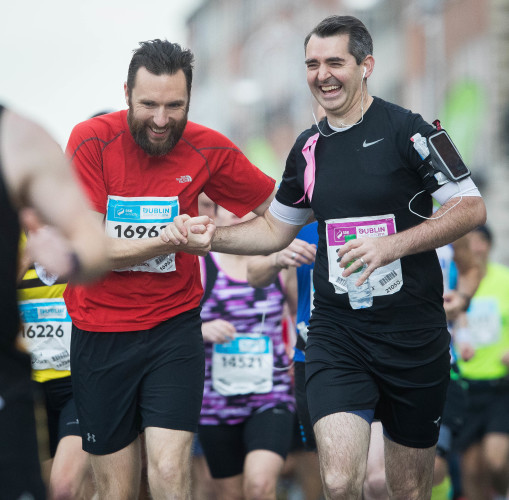HERE’S THE THIRD of your fortnightly marathon blogs, folks.
First of all, apologies for being a couple of days late. I had week 4 to finish off before I said I’d put fingers to keypad and update you on my progress to date.
I went to the Curragh yesterday for a 9-mile run, but only ended up getting five done.
I’m not a ‘sun runner’, the heat really gets to me when I’m out on a run and I could only manage five, straight up.
In 25 degrees celsius, it just wasn’t in me and when I look back on it, I have to admit that I wasn’t in the right frame of mind driving out there in the first place.
I find I always run best in the evenings, and over the past few weeks, it’s not been unusual for me to run at 10pm or later. It’s cooler, obviously, and with the headphones in, it’s a good way to process the happenings of the day.
When you’re on a plan, and I’ve been working off this one, you simply have to get the miles in.
I should have ran 9 last weekend but had fallen behind in the programme (my fault entirely).
But I did manage to get 9 in, earlier today in much cooler conditions. I didn’t hammer it, I went along at a steady pace and combining the five from yesterday, along with today’s 9, that’s 14 miles in two days.
I’m happy with that but even happier that I managed to get the nine in, because the Curragh beat me yesterday and I was massively deflated on the way home.
I knew that I was under pressure even on my first mile. I didn’t feel good, was low on energy, and the Curragh’s a pretty exposed place.
I could feel the sun beating down on my head and while I struggled through four miles, the prospect of five more wasn’t hugely appetising.
I managed to struggle through one more before admitting defeat. It’s something I’ve rarely done but it was simply too hot. Lesson learned. Don’t go out in high temperatures in the middle of the day.
But if you’re pretty new to long-distance running, you’ll quickly discover that you’re more resilient than you think you are.
I couldn’t leave the rest of the week without getting that 9-mile run done and so, with more than a little encouragement from my wife Lisa, I resolved to get those miles in today.
As I sit here now typing this, I’m tired but happy. To complete week five of the programme, I can get three done tomorrow, three on Friday and take Saturday off, before clocking up a 10-miler on Sunday.
It’s not the way it should be on the programme, I stress, but at least I’m ticking all of the boxes. And by next Sunday evening, after straying from the programme, I’ll be right back on track.
A wider point to consider is this: don’t beat yourself up if you miss out on a shorter run during the week. But do beat yourself up if you don’t hit the big weekend targets. They’re there for a reason.
The midweek runs are for maintenance and building up the engine but the long run at the weekend is a must.
Here’s how my recent training regime looks:
It’s scattered and while I haven’t always been running on the days that I should have been, I still haven’t missed a session.
For example, 9 should have been last weekend, but it was done today. I should have been running five today, but it was done yesterday.
Week five or your plan should look like this:
Monday: Rest
Tuesday: 3 miles
Wednesday: 5 miles
Thursday: 3 miles
Friday: Rest
Saturday: 10 miles
Sunday: Cross training
Instead, it’s going to look something like this for me:
Monday: 3 miles
Tuesday: 5 miles
Wednesday: 9 miles
Thursday: 3 miles
Friday: 3 miles
Saturday: Rest
Sunday: 10 miles
Not ideal, but come Sunday, I’ll have banked up 33 miles in seven days, and that’s ok too.
Hopefully, you’ve already started on week 5, which should look as follows:
Monday: Rest
Tuesday: 3 miles
Wednesday: 5 miles
Thursday: 3 miles
Friday: Rest
Saturday: 10 miles
Sunday: Cross training
And week 6, as follows:
Monday: Rest
Tuesday: 3 miles
Wednesday: 5 miles
Thursday: 3 miles
Friday: Rest
Saturday: 7 miles
Sunday: Cross training
You might not be looking forward to the 10 miles at the weekend but keep in the back of your mind that you drop back to 7 a week later. There’s science in all of this, so stick with it!
******
To finish up this week, I’m bringing you some tips from former Dublin hurler Joey Boland and the Sports Physio Ireland team.
- Respect previous injuries by addressing possible subsequent deficits in your warm ups and cool downs as well as implement injury prevention strategies as part of your training. Check out this link for more info.
- Monitor your training regime (i.e. training load) and your body’s response. A realistic plan must be put in place in order to achieve a goal like running a marathon. We often say respect the 10% rule which refers to not increasing your training load by more than 10% day to day. Small increments will help your body adapt to more effort and longer-distance runs. In this way, you can achieve top performance without risking injuries and overtaxed muscles. Check out this link for more info, and there’s really useful information here on how you can help to prevent the most common running injuries.
- Add strength exercises to your training. Running involves a lot of effort for your muscles – all of your muscles. Your legs do not do all the work, but also your arms and your back. Keeping a good posture during running is critical and this requires trained muscles which can withstand intense effort. You can build more strength through simple and easy exercises, which you can do at home. Again, refer to this link for more information.
- Recovery, training for a marathon is not only about putting in the runs. The time spent not running is also vital for recovery to enable continue performance improvements as well as prevent injuries. This involves getting your sleep in, eating right, stretching, and the occasional massage can help aid a runner’s recovery, to prepare for the next training session.
As always, you can leave your feedback in the comments section below…
The42 is on Instagram! Tap the button below on your phone to follow us!





